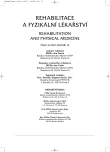-
Medical journals
- Career
Examination of Working Potential according toe Isernhagen Work Systems FCE (Description According to Available Literature)
Authors: M. Brunclíková; A. Vávra; A. Karnetová; P. Bosák
Authors‘ workplace: Rehabilitační centrum, Krajská nemocnice Pardubice
Published in: Rehabil. fyz. Lék., 14, 2007, No. 2, pp. 50-59.
Category: Original Papers
Overview
There is still lacking a standardized tool for the examination of working potential of the individual in physical area in the Czech Republic. The methods used cover the problem only in part, not being sufficiently precise and valid at the same time. In the world practice there are various tools for this purpose. Special position among them is held by tests performed in the laboratory environment, evaluating individual physical components of the working process – FCE (Functional Capacity Evaluation) in the analytical way. Following an analysis the authors selected (in their opinion) the most suitable method – Insernhagen WS FCE – for the validation and application in our conditions. The paper provides a detailed description of the methods (in respecting copyright) and additional tests making the diagnostics more precise.
Key words:
working potential, analytical tests, diagnostics
Sources
1. Dictionary of Occupational Titles. Fourth edition: U. S. Dept. of Labor Employment and Training Administration, 1991
2. KING, P. M., TUCKWELL, N., BARRET, T. E.: A critical review of functional capacity evaluatkons. Physical Therapy, 8, 1998 pp. 852-866.
3. KAISER, H., KERSTING, M., SCHIAN, H. M.: Der Stellenwert des Arbeitssimulationsgerätes ERGOS als Bestandteil der leistungsdiagnostischen Begutachtung. Rehabilitation, 39, 2000 pp. 175-184.
4. JOHNSON, L. J., MILLER, M.: Functional testing: Approaches and injury management integration. Work, 16, 2001, pp. 7-11.
5. GARDENER, L., MCKENNA, K.: Reliability of occupational therapists in determining safe, maximal lifting capacity. Australian Occupational Therapy Journal, 16, 1999, pp. 110-119
6. ISERNHAGEN, S. J. HART, D. L., MATHESON, L. M.: Reliability of independent observer judgements of level of lift effort in a kinesiophysical Functional Capacity Evaluation. Work,12, 1999, pp. 145-150.
7. ARONOFF, G. M., FELDMAN, J. B.: Preventing disability from chronic pain: a review and reappraisal. International Review of Psychiatry, 2, 2000, pp. 157-169.
8. FAVILLE, B., SCHULENBERG, CH.: Applying manual material-handling guidelines to job tasks. Occupational Hazards, 66, 2004, 11, pp. 36-38.
9. DEMPSEY, P. G.: Usability of the revised NIOSH lifting equation. Ergonomics, 12, 2002, pp. 817-828.
10. WATERS, T. R., PUTZ-ANDERSSON, V., GARG, A.: Application manual for the revised NIOSH lifting equation. U. S. Department of Health and Human Services, Centers for Disease Control and Prevention, NIOSH, Division of Biomedical and Behavioral Science, Cincinatti (OH), 1994.
11. MARKLIN, R. W., WILZBACHER, J. R.: Four assessment tools ofergonomics intervention: Case study at an electric utility’s warehouse system. American Industrial Hygiene Association Journal, 60, 1999, pp. 777-784.
12. WANG, M. J. J., GARG, Q., CHANG, Y. C. et al.: The relationship between low back discomfort ratings and the NIOSH lifting index. Human Factors, 3, 1998, pp. 509-515.
13. FISHER, G. S.: Administration akd application of the Worker role interview: looking beyond functional capacity. Work, 12, 1999, pp. 13-24.
14. KIELHOFNER, G., BRAVEMAN, B., BARON, K. et al.: The model of human occupation: understanding the worker who is injured or disabled. Work, 12, 1999, pp. 37-45.
15. BOOTES, K., CHAPARRO, C. J.: Cognitive and behavioural assessment of people with traumatic brain injury in the work place: Occupational therapists’ perception. Work, 19, 2002, pp. 255-268.
16. RENEMAN, M. F., FOKKENS, A. S., DIJKSTRA, P. U. et al.: Testing lifting capacity: Validity of dotermining effort level by means of observation. SPINE, 2005, 2, pp. 40-46.
17. RENEMAN, M. F., JAEGERS, S. M. H. J., WESTMAAS, M. et al.: The reliability of determining effort level of lifting and carryiong in a functional capacity evaluation. Work, 18, 2002, pp. 21-27.
18. RENEMAN, M. F., JOLING,C. L., SOER, E. L. et al.: Functional capacity evaluation: Ecological validity of three static endurance tests. Work, 16, 2001, pp. 227-234.
19. JONES, T., KUMAR, S.: Functional capacity evaluation of manual materials handlers: a review. Disability and Rehabilitation, 2003; 4-5, pp. 179-191.
20. INNES, E., STRAKER, L.: Validity of work-related assessments. Work, 13, 1999, pp. 125-152.
21. SCHIAN, H. M., KAISER, H.: Profilvergleichungssysteme und leistungsdiagnostische EDV-gestützte Technologie - ihr Einsatz zur Verbesserung der Beantwortung sozialmedizinischer Fregestellungen und Begutachtungen sowie der Planung von Rehabilitationmassnahmen. In: Hinweise aur Bewertungsinstrumente zur Qualitätssicherung in der Rehabilitation - Blatt 18. Koordinator Schuntermann MF. Frankfurn a/M 2000.
22. GOUTTEBARGE, V., WIND, H., KUIJER, P. P. F. M.: Reliability and validity of functional capacity evaluation mathods: a systematick review with reference to Blankenship systém, Ergos work simulator, Ergo-Kit and Isernhagen work systém. Int. Arch. Occup. Environ. Health, 77, 2004, pp. 527-537.
Labels
Physiotherapist, university degree Rehabilitation Sports medicine
Article was published inRehabilitation & Physical Medicine

2007 Issue 2-
All articles in this issue
- Importance of Musculus Rectus Femoris in Patients with Children Brain Palsy
- Functional Examination of Pelvic Floor
- ain Syndromes and Neuralgic Amyotrophy of Brachial Plexus – a Contribution to Differential Diagnostics
- Functional Diagnostics in Rehabilitation for the Employment Purpose
- Examination of Working Potential according toe Isernhagen Work Systems FCE (Description According to Available Literature)
- Determination of the Working Potential of the Individual
- Balance Diagnostics, Ergodiagnostics and a Description of the Workplace
- Examination of Consistence of Endeavour in Physical Working Capacity Tests
- Rehabilitation & Physical Medicine
- Journal archive
- Current issue
- Online only
- About the journal
Most read in this issue- ain Syndromes and Neuralgic Amyotrophy of Brachial Plexus – a Contribution to Differential Diagnostics
- Functional Examination of Pelvic Floor
- Determination of the Working Potential of the Individual
- Examination of Working Potential according toe Isernhagen Work Systems FCE (Description According to Available Literature)
Login#ADS_BOTTOM_SCRIPTS#Forgotten passwordEnter the email address that you registered with. We will send you instructions on how to set a new password.
- Career

